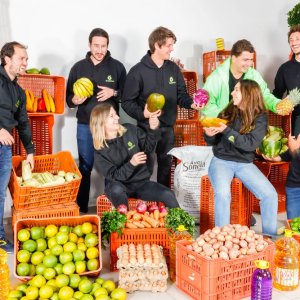Choose Crickets to Reduce Your Carbon Footprint

STORY INLINE POST
Have you ever measured your carbon footprint? Or do you even know that it exists? It does and it is important to know which is your level of pollution, including carbon dioxide and methane, it is based on how many people live in your household, how much do they earn, your decision-making regarding travel, home, food, shopping, among others. “The average carbon footprint for a person in the US is 16 tons, one of the highest rates in the world. Globally, the average carbon footprint is closer to 4 tons.” (Nature Organization, 2022) It is important to be aware of our footprint because global warming is an important issue that is happening right now, even as you read this article. To avoid a 2ºC rise in global temperature, we need to decrease our carbon footprint from 16 tons to 2 tons by 2050. If you make small changes in your daily activities, such as choosing different food protein alternatives that have high nutritional benefits and low environmental impact, such as insects, you are making a real change.
In the last few years, consumers have become more conscious about the products they are eating and which is the story behind the brand. They are also pointing out if a food brand has a clean label or not, which means that a product has a maximum of five ingredients in the total formula, you can recognize and pronounce them. For example, if you review a snack and you find these ingredients: maltodextrin (a type of sugar) and monosodium glutamate (a type of salt), Most of us cannot even pronounce them and know what they are. Most diseases are based on what we eat due to the high amount of chemicals that some products have and we don't even know the risk of consuming them. “Researchers at George Washington University bought fast foods from popular outlets and found 10 of 11 potentially harmful chemicals in the samples, including phthalates, a group of chemicals that are used to make plastics soft and are known to disrupt the endocrine system.” (George Washington University, 2021)
Taking this into account, have you ever thought about how many chemicals a nugget has? It contains more chemicals than chicken. The different products cause health problems and have a negative impact on the environment, which means that you are increasing your carbon footprint. For example, cardiovascular diseases, such as heart attack or stroke, are developed by the use of excessive salt in products. “Among noncommunicable risk factors, high blood pressure is called the silent killer. It already kills 9.4 million each year globally and if we do nothing about it today, it will kill 1 billion people prematurely in this century,” said Dr Shin Young-soo, WHO Regional Director for the Western Pacific. Hidden salt in processed foods is the main culprit, including chips, bread, soup stock cubes and consumed processed foods. Moreover, attention deficit disorder in children can be the result of colorants and chemicals in snacks, and last but not least, diabetes is due to the high amount of sugar and carbs in daily life.
Taking into consideration the health problems that can be caused by processed food, insects could be a solution, for both decreasing your carbon footprint by their low environmental impact and because they have a high nutritional benefit. For instance, Crick Superfoods is an Ecuadorian snack brand based on cricket protein powder that offers healthy, gluten-free snacks that are whey-free protein, high in fiber, iron, calcium, nine amino-acids and vitamin B12 . Crick Superfoods does not use whey protein based on two factors: the impact of cattle on global warming and because people who are lactose intolerant may be sensitive to it. “In factory farming, cows and their manure release methane emissions that contribute to climate change. Consider that each cow produces an average of 81.5 pounds of waste every day, and multiply that by 9.4 million dairy cows in the US alone.” (The Humane League, 2022). Therefore, methane is 30 times more heat than carbon dioxide and it represent 20 percent of global greenhouse gas emissions. This is an example of how eating meat increases your carbon footprint because it has a significant repercussion on global warming, causing climate change and unusual weather patterns. Taking this into account, Crick Superfoods produces high-protein tortilla chips, for which the protein level is based on a percentage of cricket flour and bean flour, ensuring that each 50-gram bag has 20 percent protein, four times more than the average snack in the Ecuadorian market and it represents almost as eating an egg but it is easier to carry a snack bag than a boiled egg. Additionally, the brand does not use any preservatives or additives due to its commitment to have a clean label, meaning consumers can understand each of the ingredients: corn flour, bean flour, cricket protein powder, sea salt, water and vegetable oil.
Crick Superfoods has revolutionized the snack market using an ento-ingredient cricket species, called Gryllus Assimilis, Familia: Grillidae, Orden: Orthoptera. This species has been selected by the UN Food Agriculture Organization (FAO) as edible insects. “Entomophagy is the practice of eating insects, and inclusion of edible insects in the diet has been followed by humans for many years, especially among some of the ethnic groups of South America, Mexico, Africa, and Asia. Entomophagy is considered a potent dietary practice to replace animal protein due to its highly nutritious, protein-rich, and environmentally sustainable nature.” (Siddaraju Anusha, Pradeep Singh Negi, 2022) “Ento” comes from the word root entomophagy and is one of the raw materials for the production of Crick Superfoods products. The main objective of the brand is not just to sell tortilla chips, it is to raise awareness about the different sustainable protein alternatives, such as insects, breaking the taboos of consuming them and boosting the proposition value of being high in protein and low environmental impact.
The cricket species are raised in an indoor vertical farm, SarGrillo. It has a wildlife management patent, which ensures that the cricket species are edible insects for human consumption. That patent is granted by the Ministry of the Environment of Ecuador, which guarantees the safety and the management of the species. Taking into consideration the size of the insect and that it is raised in an indoor vertical farm, it occupies the cubic meter of the entire room. That makes a big difference in the use of space compared to most proteins where square meters are occupied. For instance, you cannot put a pig on top of another pig but in a cricket farm, you can put a cricket on top of another cricket. As a vertical farm, you have shelves for the different levels of the cricket's life cycle where these are stored in drawers, with each drawer housing more than 1,000 crickets. SarGrillo uses three times less space than any other animal protein farm, ccomplishing all food safety procedures. Crickets eat fresh fruits and vegetables, which helps them absorb different nutrients, such as Vitamin C from oranges. From its upbringing to the dehydration and grinding process to obtain 1 pound of cricket flour, only 1 gallon of water is used. “The amount of water usage necessary to produce 1 pound of beef, proves to be an estimated 1,799 gallons of water. Compare this with 576 gallons of water for 1 pound of pork, 216 gallons for 1 pound of soybeans.” (Union College, 2018) The amounts of water used by different proteins, either of animal or vegetable origin, are higher than crickets. It is considered a sustainable protein due to its low use of water and efficient use of space. Other benefits include using their defecation as fertilizer, making it a circular economy. When making flour from crickets, the entire insect is used and there is no waste. In fact, because their entire skeleton is ground, it means the protein powder is high in iron and calcium.
As mentioned, crickets could be a good solution to decrease your carbon footprint by consuming alternative proteins that are environmentally friendly options. Crickets have nutritional benefits: nine amino-acids, 60 percent of protein per 100 grams of cricket flour, high in fiber, calcium, iron and probiotics that are located in the wings, called chitin, which help our digestive system be 80 percent more digestive than any other protein. Thus, our food choices are important for both nutrition and the environment. Each of the actions that we take daily contribute to the tons of carbon that we emit. Most of us have never analyzed the carbon footprint but if you are curious check the Nature Organization calculator, where you can track it by entering your city, postal code, food, travel and shopping choices.
In the future, there will be a lack of water and space and overexploitation of agricultural land, meaning there will not be enough food for animals and humans. Therefore, you can make the decision to eat less meat and try new alternative proteins, such as insects, separate waste, use less water when brushing our teeth and even bathing, among others. Small actions can have a giant impact, ensuring a better planet for ourselves and future generations to enjoy.
Sources:
https://thehumaneleague.org/article/why-are-cows-bad-for-the-environment
https://www.nature.org/en-us/get-involved/how-to-help/carbonootprint-calculator/
https://gwtoday.gwu.edu/potentially-harmful-industrial-chemicals-detected-us-fast-foods
https://www.sciencedirect.com/topics/agricultural-and-biological-sciences/entomophagy
























